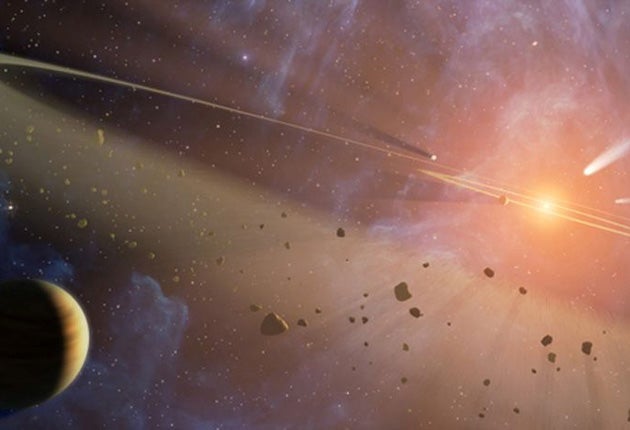Life first emerged in ‘warm little ponds’ almost as old as the Earth itself
Charles Darwin's famous idea backed by new scientific study

Your support helps us to tell the story
From reproductive rights to climate change to Big Tech, The Independent is on the ground when the story is developing. Whether it's investigating the financials of Elon Musk's pro-Trump PAC or producing our latest documentary, 'The A Word', which shines a light on the American women fighting for reproductive rights, we know how important it is to parse out the facts from the messaging.
At such a critical moment in US history, we need reporters on the ground. Your donation allows us to keep sending journalists to speak to both sides of the story.
The Independent is trusted by Americans across the entire political spectrum. And unlike many other quality news outlets, we choose not to lock Americans out of our reporting and analysis with paywalls. We believe quality journalism should be available to everyone, paid for by those who can afford it.
Your support makes all the difference.Life on Earth began up to 4.5 billion years ago as carbon-rich meteors bombarded the planet and leached the essential elements into “warm little ponds”, according to new research.
It was in this nutrient-rich broth that the first self-replicating molecules, with the first genetic code for life, were born.
While the idea we are descended from something that emerged in “warm little ponds” was suggested by Charles Darwin in the 19th century, it has been challenged by claims it all started around hydrothermal vents in the ocean.
But, in a new paper in the journal Proceedings of the Academy of Sciences (PNAS), researchers described how they had constructed a “comprehensive model” proving Darwin’s idea was plausible.
The earliest genetic material is believed to have been ribonucleic acid or RNA, which every human has along with DNA. While DNA is like the “blueprint” of a cell, the RNA is involved in translating this code into proteins and has a number of other tasks in regulating processes in cells, including growth, ageing and death.
In the PNAS paper, the scientists wrote: “One of the most fundamental questions in science is how life first emerged on Earth.
“Given its ubiquity in living cells and its ability to both store genetic information and catalyse its own replication, RNA probably formed the basis of first life.”
They pointed to fossil evidence of life dated to more than 3.7 billion years ago.
“Thus the RNA world would have developed on a violent early Earth undergoing meteoritic bombardment,” the researchers wrote.
“At that time, the atmosphere was dominated by volcanic gases, and dry land was scarce as continents were rising out of the global ocean.”
Their model suggested the first RNA polymers “likely appeared before 4.17 billion years ago” and possibly as long ago as 4.5 billion years. Planet Earth itself is thought to be about 4.54 billion years old.
If life is truly as old as this, it suggests a number of things.
One is that simple life is likely to be common in the universe as it can survive in hostile conditions. At the time, the Earth was not shielded by a protective layer of ozone to filter out harmful ultraviolet rays from the Sun in addition to meteor bombardment.
But it also could be a sign that intelligent life takes a long time to develop and is therefore likely to be rare. The universe, at about 13.8 billion years, is only three times older than Earth.
The researchers drew on astrophysics, geology, chemistry, biology and other fields to develop their model of the creation of life.
One of the authors of the paper, Professor Ralph Pudritz, of McMaster University in Canada, said the evidence seemed to be pointing in one direction.
“Because there are so many inputs from so many different fields, it’s kind of amazing that it all hangs together,” he said.
“Each step led very naturally to the next. To have them all lead to a clear picture in the end is saying there’s something right about this.”
“We’re thrilled that we can put together a theoretical paper that combines all these threads, makes clear predictions and offers clear ideas that we can take to the laboratory.”
He said it seemed clear that RNA would have evolved before DNA.
“DNA is too complex to have been the first aspect of life to emerge,” Professor Pudritz said. “It had to start with something else, and that is RNA.”
Ben Pearce, a graduate student at McMaster who co-wrote the paper, said this was the first time all the evidence had been put into a model.
“No one’s actually run the calculation before. This is a pretty big beginning. It’s pretty exciting,” he said.
It is thought the first molecules replicated themselves – the most basic definition of life – by folding over and drawing in similar material from the environment.
This simple process began the process of evolution as molecules that were better suited to their environment became more numerous and those that were not ‘died’ out.
Understanding this process, Mr Pearce said, was “the Holy Grail of experimental origins-of-life chemistry”.
Join our commenting forum
Join thought-provoking conversations, follow other Independent readers and see their replies
Comments